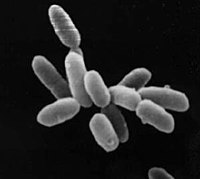Halobacterium
| Halobacterium | |
|---|---|

| |
| Halobacterium sp. strain NRC-1, each cell about 5 μm in length. | |
| Klasifikasi ilmiah | |
| Domain: | |
| Kerajaan: | |
| Filum: | |
| Kelas: | |
| Ordo: | |
| Famili: | |
| Genus: | Halobacterium
|
| Nama binomial | |
| Halobacterium Elazari-Volcani 1957
| |
| Species | |
| Sinonim | |
| |
- Catatan: Kata "halobacterium" juga merupakan bentuk tunggal dari kata "halobacteria".
Dalam taksonomi, Halobacterium adalah genus dari Halobacteriaceae.[1]
Referensi sunting
- ^ See the NCBI webpage on Halobacterium Diarsipkan 2022-05-24 di Wayback Machine.. Data extracted from the "NCBI taxonomy resources". National Center for Biotechnology Information. Diarsipkan dari versi asli tanggal 2019-01-24. Diakses tanggal 2007-03-19.
Bacaan lebih lanjut sunting
Jurnal ilmiah sunting
- DasSarma, S., B.R. Berquist, J.A. Coker, P. DasSarma, J.A. Müller. 2006. Post-genomics of the model haloarchaeon Halobacterium sp. NRC-1. Saline Systems 2:3. Diarsipkan 2011-10-02 di Wayback Machine.
- Judicial, Commission of the International Committee on Systematics of Prokaryotes: (2005). "The nomenclatural types of the orders Acholeplasmatales, Halanaerobiales, Halobacteriales, Methanobacteriales, Methanococcales, Methanomicrobiales, Planctomycetales, Prochlorales, Sulfolobales, Thermococcales, Thermoproteales and Verrucomicrobiales are the genera Acholeplasma, Halanaerobium, Halobacterium, Methanobacterium, Methanococcus, Methanomicrobium, Planctomyces, Prochloron, Sulfolobus, Thermococcus, Thermoproteus and Verrucomicrobium, respectively. Opinion 79". Int. J. Syst. Evol. Microbiol. 55 (Pt 1): 517–518. doi:10.1099/ijs.0.63548-0. PMID 15653928.
- Oren A, Ventosa A (2000). "International Committee on Systematic Bacteriology Subcommittee on the taxonomy of Halobacteriaceae. Minutes of the meetings, 16 August 1999, Sydney, Australia". Int. J. Syst. Evol. Microbiol. 50: 1405–1407. PMID 10843089.
Buku ilmiah sunting
- DasSarma, S. 2004. Genome sequence of an extremely halophilic archaeon, in Microbial Genomes, pp. 383–399, C.M. Fraser, T. Read, and K.E. Nelson (eds.), Humana Press, Inc, Totowa, NJ.
- Lynn Margulis, Karlene V.Schwartz, Five Kingdoms. An Illustrated Guide to the Phyla of Life on Earth (W.H.Freeman, San Francisco, 1982) pp. 36–37
- Gibbons, NE (1974). "Family V. Halobacteriaceae fam. nov.". Dalam RE Buchanan and NE Gibbons, eds. Bergey's Manual of Determinative Bacteriology (edisi ke-8th). Baltimore: The Williams & Wilkins Co.
- Elazari-Volcani, B (1957). "Genus XII. Halobacterium Elazari-Volcani, 1940". Dalam RS Breed, EGD Murray, and NR Smith, eds. Bergey's Manual of Determinative Bacteriology (edisi ke-7th). Baltimore: The Williams & Wilkins Co. hlm. 207–212.
- Elazari-Volcani, B (1940). "Studies on the microflora of the Dead Sea". Doctoral dissertation, Hebrew University, Jerusalem: 1–116 and i–xiii.
Database ilmiah sunting
- Referensi PubMed untuk Halobacterium
- Referensi PubMed Central untuk Halobacterium
- Referensi Google Scholar untuk Halobacterium
Bacaan lebih lanjut sunting
- ^ PIJPER A (1953). "Halobacterium halobium". J Gen Microbiol. 8 (1): viii. PMID 13035061.
- ^ BAYLEY ST, KUSHNER DJ (1964). "THE RIBOSOMES OF THE EXTREMELY HALOPHILIC BACTERIUM, HALOBACTERIUM CUTIRUBRUM". J Mol Biol. 9 (3): 654–69. doi:10.1016/S0022-2836(64)80173-X. PMID 14216609.
- ^ Oesterhelt D, Stoeckenius W (1974). "Isolation of the cell membrane of Halobacterium halobium and its fractionation into red and purple membrane". Methods Enzymol. Methods in Enzymology. 31 (Pt A): 667–78. doi:10.1016/0076-6879(74)31072-5. ISBN 978-0-12-181894-4. PMID 4418026.
- ^ Oesterhelt D, Stoeckenius W (1971). "Rhodopsin-like protein from the purple membrane of Halobacterium halobium". Nat New Biol. 233 (39): 149–52. Bibcode:1971Natur.233..149.. doi:10.1038/233149b0. PMID 4940442.
- ^ Stoeckenius W, Bogomolni RA (1982). "Bacteriorhodopsin and related pigments of halobacteria". Annu Rev Biochem. 51: 587–616. doi:10.1146/annurev.bi.51.070182.003103. PMID 6287921.
- ^ Lozier RH, Bogomolni RA, Stoeckenius W (1975). "Bacteriorhodopsin: a light-driven proton pump in Halobacterium Halobium". Biophys J. 15 (9): 955–62. Bibcode:1975BpJ....15..955L. doi:10.1016/S0006-3495(75)85875-9. PMC 1334761 . PMID 1182271.
- ^ Ng WV, Kennedy SP, Mahairas GG, Berquist B, Pan M, Shukla HD, Lasky SR, Baliga NS, Thorsson V, Sbrogna J, Swartzell S, Weir D, Hall J, Dahl TA, Welti R, Goo YA, Leithauser B, Keller K, Cruz R, Danson MJ, Hough DW, Maddocks DG, Jablonski PE, Krebs MP, Angevine CM, Dale H, Isenbarger TA, Peck RF, Pohlschroder M, Spudich JL, Jung KW, Alam M, Freitas T, Hou S, Daniels CJ, Dennis PP, Omer AD, Ebhardt H, Lowe TM, Liang P, Riley M, Hood L, DasSarma S (2000). "Genome sequence of Halobacterium species NRC-1". Proc Natl Acad Sci U S A. 97 (22): 12176–81. Bibcode:2000PNAS...9712176N. doi:10.1073/pnas.190337797. PMC 17314 . PMID 11016950.